Restriction reviews and exciting withdrawals
Jared Davidson, Research Librarian for Manuscripts writes about the Turnbull Library's process for managing access to sensitive material and work we have done to review the process. He highlights some of the human stories this work has revealed.
What’s a Chief Librarian restriction?
Some Alexander Turnbull Library collections have access restrictions and require permission to be viewed. One of the access levels is called ‘Chief Librarian restriction’. To access material with a Chief Librarian restriction, researchers need to submit a written request to the Chief Librarian.
The Alexander Turnbull Library has used the Chief Librarian restriction to manage access to sensitive material for approximately 50 years. The addition of the Chief Librarian restriction often came about during negotiations with a donor or was added to certain collections by the Library, such as those without a deed of gift.
In many circumstances a Chief Librarian restriction is entirely appropriate. Whether for privacy, legal or ethical reasons, or to respect the wishes of the donor, a restriction ensures that both researchers and the Library are clear about how sensitive material can be accessed and shared.
Today, we only apply Chief Librarian restrictions in exceptional circumstances. We encourage donors to decide on the most appropriate access conditions and to be the access contact for restricted material. We also set release dates so that researchers have a clear idea of when a restriction will end. But this wasn’t always the case.
However, some collections have a Chief Librarian restriction for no apparent reason. Or perhaps the terms of the deed have lapsed or are no longer valid, such as limiting access to only “bona fide researchers” (all of our researchers are bona fide!)
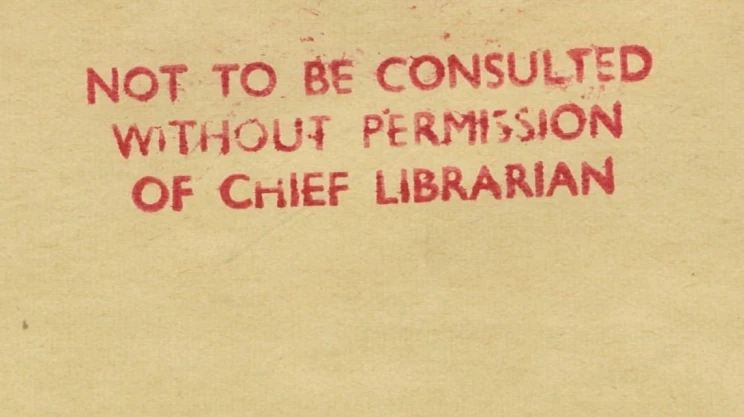
"Not to be consulted without permission of Chief Librarian."
Reviewing the Chief Librarian restriction
There are 243 manuscript collections with a Chief Librarian restriction. In 2020, to make things easier for researchers and staff, the Library began developing a framework to address these collections.
The Chief Librarian Restriction Review created a set of guidelines and criteria to help us decide if changes could be made to a Chief Librarian restriction. The changes included considering if the restriction could be removed, partially removed or maintained with a release date added. We also created a set of access principles to guide the current and future use of Chief Librarian restrictions.
This kind of work isn’t glamourous, it's time consuming and doesn’t make for riveting reading. But having the right tools to do our job not only helps us, it also benefits our donors and researchers — both now and in the future. The guidelines help us balance the need to uphold the original intent of our donors while removing unnecessary barriers to access. It also means that, where appropriate, we can remove unnecessary restrictions.
Six months into the review
We’re now six months into implementing the Chief Librarian Restriction Review and its guidelines. As the Research Librarian Manuscripts, I apply these guidelines to restricted manuscript collections as part of my day-to-day work.
It involves drawing on the research of Audrey Stratford, Rata Holtslag and others during the early phases of the project; looking into background documentation such as deeds and correspondence; requesting and checking physical material; consulting with donors; working with curators or colleagues in the Arrangement and Description team; and making recommendations to the Chief Librarian. Every decision is documented.
At the time of writing, we’ve reviewed 32 manuscript collections: over 300 boxes, 3,670 folders and 1,370 volumes. Most of these have had their former Chief Librarian restriction removed. In some cases (160 folders), we’ve maintained the restriction but added a release date to respect the privacy of living individuals.
Human stories lie behind the statistics
Behind the statistics lie very human stories. Cecil Franks served with the Royal New Zealand Air Force 488 Squadron during the Second World War. A month before he departed for Singapore in September 1941, he married Eunice Frances Hudson. Soon he was writing detailed letters to his new wife, peppered with lots of “don’t worry” and other reassurances that he was keeping out of trouble. But trouble soon found him.
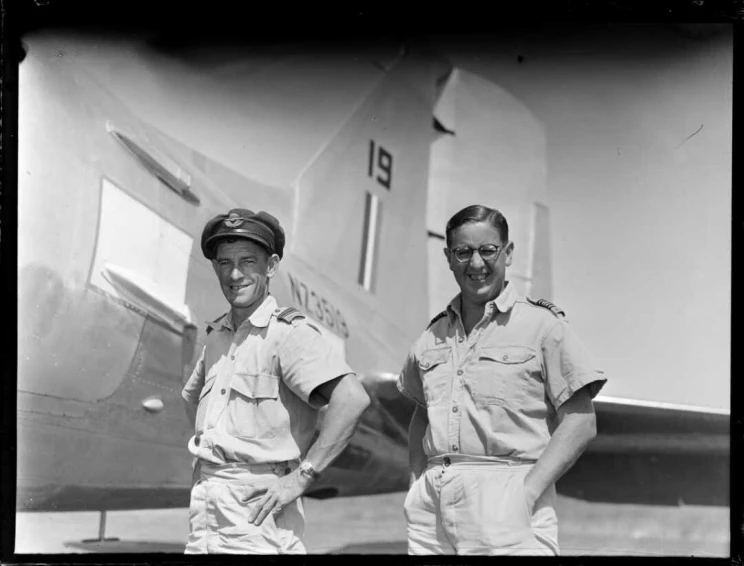
Portrait of Second Lieutenant Cecil Franks on right, and Flight Lieutenant N S Irvine in front of a Dakota transport plane, Tontouta Airfield, New Caledonia, 1945. Whites Aviation Collection, ref: WA-01077-G. Alexander Turnbull Library.
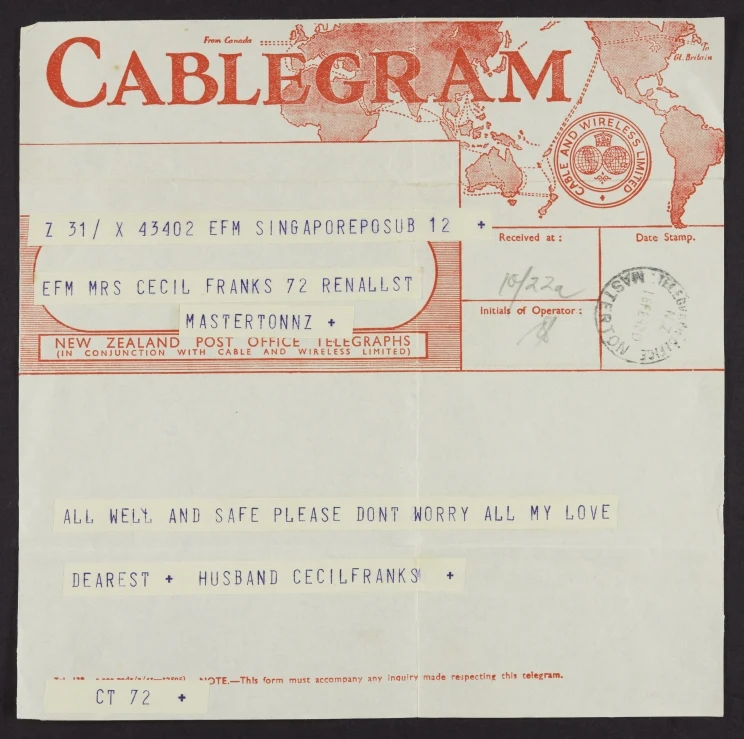
Telegram from Cecil Franks in Singapore to his wife in Masterton, "ALL WELL AND SAFE PLEASE DON'T WORRY ALL MY LOVE. DEAREST + HUSBAND CECILFRANKS +". Ref: MS-Papers-11648-07.
The fall of Singapore “An exciting withdrawal”
Amongst official telegrams to Eunice, announcing her husband’s evacuation to Australia, is Cecil’s lengthy account of the fall of Singapore in February 1942: the fast-moving Japanese advance through coconut trees, flames licking the skyline, and a hasty evacuation aboard the crowded steam ship Empire Star. “I raced down to Ramsgate Road to throw my belongings together” wrote Cecil. “While there the area was machine-gunned by low flying enemy fighters. Time only permitted the packing of essentials, and I had to leave all my uniforms and much other material.”
“Three things however”, Cecil saved at all costs: “your letters, the photograph album of the trip, and Pop’s camera.” This salvaged album is also held by the Turnbull (PA1-o-1866) and can be accessed digitally online.
Photograph album of Cecil Franks' service during World War II
Other letters held in Cecil’s papers (MS-Group-2263) document the later stages of the war, adding a further layer of meaning to the photographs.
With the passing of Eunice in 2013 and after reviewing the collection, the Chief Librarian restriction on these letters was removed.
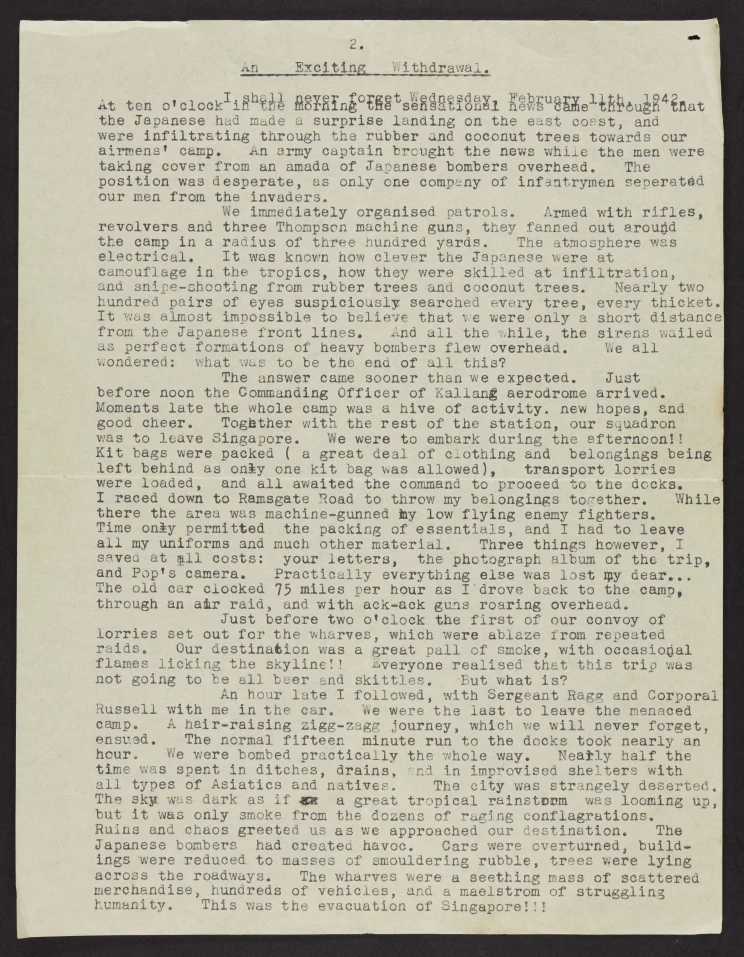
Page two of Cecil’s letter to Eunice describing the fall of Singapore, February 1942. ‘Outwards correspondence – Eunice Franks’. Ref: MS-Papers-11648-07.
A page from Cecil’s rescued photo album, showing the Japanese bombing of the squadron’s aerodrome in January 1942. Ref: PA1-o-1866. Alexander Turnbull Library.
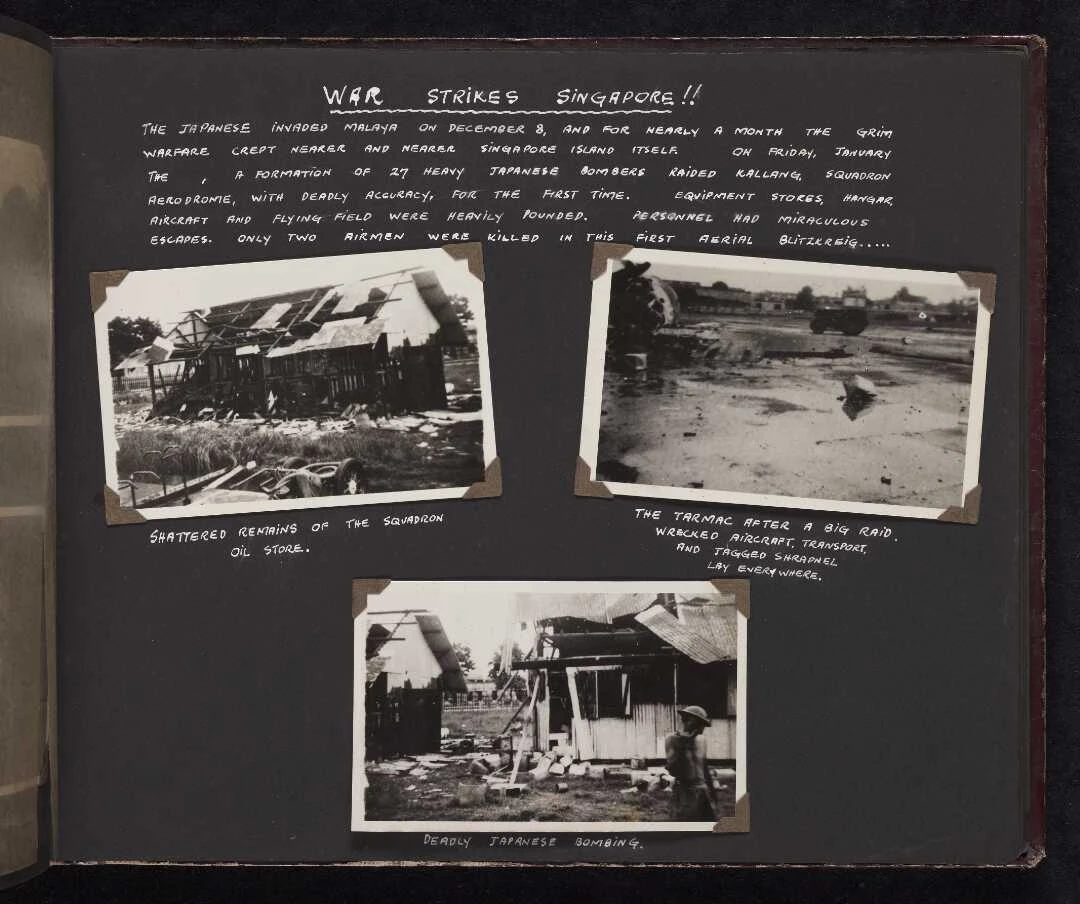
Sample of reviewed collections
Here is a snapshot of other collections we’ve reviewed, including a number of personal papers — those collections consisting of an individual's papers, records and other documentary output.
Personal papers
McWhannell, Rhoda, 1898-1996: Diaries, journals and photographs
This collection of journals written between 1938-1986 document the Waikato farming life of Rhoda McWhannell in rich detail, including events like the Second World War, becoming a widow, international travel and running a eucalyptus nursery. Rhoda recorded her sharp observations of people and place in these journals, which are complimented by 31 photo albums (Series-6839). They are a social historian’s dream and very relevant to the new Aotearoa New Zealand Histories Curriculum.
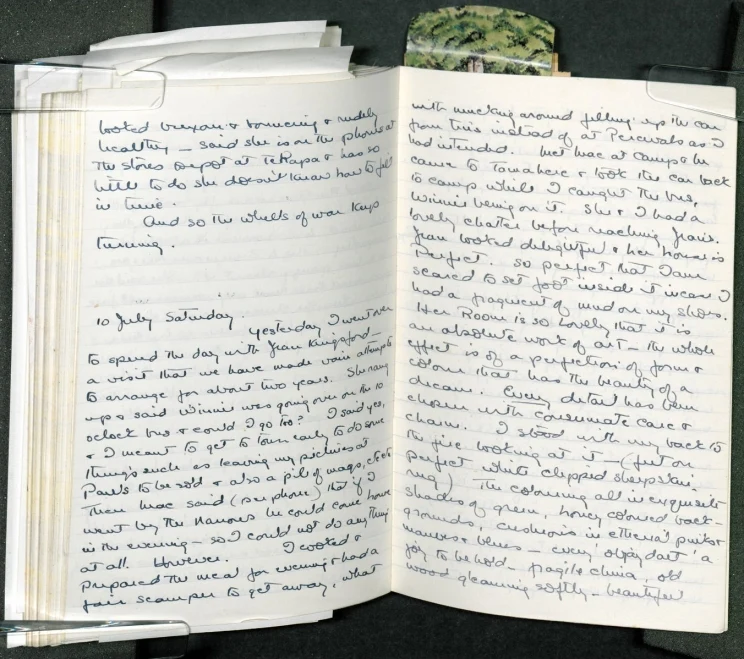
Entry in the journal of Rhoda McWhannell, February to July 1943. Ref: MSX-10117.
Cresswell, Walter D' Arcy, 1896-1960
The papers of poet, journalist and writer Walter Cresswell include correspondence to and from literary and political figures, manuscripts of his poems, plays and prose, and work by other writers. Paul Diamond, Curator, Māori at the Turnbull Library, made extensive use of the papers for his book Downfall: The Destruction of Charles Mackay, and found them an invaluable source for understanding the character of the man who blackmailed Mackay, threatening to reveal the mayor’s homosexuality unless he resigned.
“Although Cresswell wanted to be a great poet, his poetry was hard work. His prose was a different story – very readable, sharp and engaging. Cresswell also wrote a great letter.” Paul says Cresswell’s papers illustrate the key role he played in New Zealand literary life.
In a letter to his friend Ormond Wilson, about fellow writer and friend Frank Sargeson, Cresswell wrote that “…I’ve long been persuading him that we artists have obligations towards the rich, to accept what help they may offer us: it’s the only personal kindness we can do them.”
Cresswell, Walter D' Arcy, 1896-1960: Papers (MS-Papers-0170)
Pearson, William Harrison, 1922-2002
Except for three series of correspondence (which now have a release date of 2050), these papers relating to New Zealand and Pacific literature no longer have access restrictions. They include Pearson’s early literary works, the full drafts and annotated copies of his novel Coal Flat (one of New Zealand’s finest realist novels), lecture notes, articles and reviews, scrapbooks, and subject files such as the University of Auckland’s Māori Club or interpretations of Ralph Hotere's painting, ‘Mungo at Aramoana’.
Pearson, William Harrison, 1922-2002: Papers (MS-Group-0086)

First draft of page one of Coal Flat by Bill Pearson, 1949. ‘Coal Flat - Holograph draft’. Ref: MS-Papers-4343-072.
Carman, Arthur Herbert, 1902-1982
A Wellington bookseller, writer and pacifist, Arthur Carman was jailed in 1941 for his anti-war activities. His papers include newsletters, inward correspondence and notes written while he was in jail, and notes and newspaper cuttings relating to subversion cases, appeals against military service, pacifism and conscientious objectors between 1939 and 1949.
Carman, Arthur Herbert, 1902-1982: Papers (MS-Papers-2410)
Walsh, Fintan Patrick, 1894-1963
Spanning 11 linear metres and six decades, the papers of ‘Black Prince’ Fintan Patrick Walsh are a rich source of labour history, documenting his early years as a radical communist through to his anti-communist leadership of the New Zealand Federation of Labour. The papers also cover industrial relations, economic activity in New Zealand and abroad, tourism and immigration, the Second World War and much more. They form part of the Turnbull’s extensive labour movement archive, as detailed in our Labour history guide.
Walsh, Fintan Patrick, 1894-1963: Papers (MS-Papers-0274)
Bollinger, Conrad Vickers Irvine, 1929-1975
This collection includes the correspondence and personal papers of Conrad Bollinger, whose work for and about socialist/progressive causes forms an important slice of working-class heritage. As well as documenting his work as a historian and writer, the papers include Seamen’s Union and trade union records, communist material and records relating to the New Zealand Federation of Labour (and Walsh in particular). It also includes left-wing ephemera and printed material, such as pamphlets and strike bulletins.
Bollinger, Conrad Vickers Irvine, 1929-1975: Papers (MS-Papers-2151)
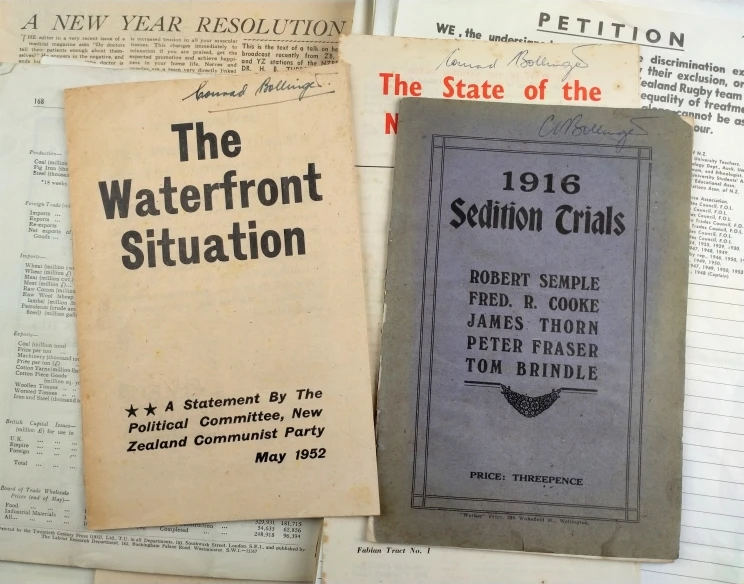
From the papers of Conrad Bollinger. ‘Personal papers and correspondence’. Ref: MS-Papers-2151-458.
Institutional and company records
New Zealand Seamen's Union and Federated Seamen's Union of New Zealand
Covering 1884-1979, these collections of important labour movement archives include minutes, correspondence, financial records, agreements and awards, records of industrial disputes and the experience of everyday working life. They also complement the personal papers of Conrad Bollinger and Fintan Patrick Walsh, which both have a strong emphasis on the Seamen’s Union.
New Zealand Seamen's Union: Records (80-307)
Federated Seamen's Union of New Zealand: Records (MS-Papers-0650)
New Zealand Christian Pacifist Society
Formed to unite Christians of all denominations in work for peace, the records of the New Zealand Christian Pacifist Society include inward and outward correspondence, periodicals, newsletters, conference papers (1967-1971) and both local and international anti-war material. The Riverside Community in Lower Moutere is well-represented, as are other groups, churches and leagues. They cover conflicts such as the Vietnam War, apartheid South Africa, conscientious objection and nuclear disarmament.
New Zealand Christian Pacifist Society: Records (74-126)
New Zealand Press Association
This collection had a lengthy access statement based on the age of the material, all of which have lapsed. Created by a co-operative of newspapers and dating from 1878, the records include minute books and letter books, correspondence with other news agencies and newspapers, files about directors, telecommunications and news subjects, financial records, circulars and legal papers. They provide an interesting snapshot of the press and politics at a time when print media was king.
New Zealand Press Association: Records (MS-Group-1143)
Dalgety New Zealand Ltd
Consisting of 80 boxes and 1154 volumes, these records were created by Dalgety New Zealand and the New Zealand Loan and Mercantile Agency. These companies were involved in the agricultural sector across Australia and New Zealand, especially wool, and at one time was the largest wool house in the world. The papers include correspondence, minute books, financial records, reports and stock records from both the Wellington head office and various South Island agencies. Complimentary collections are held in the Noel Butlin Archives, ANU, Australia and the Fletcher Trust Archives.
Dalgety New Zealand Ltd: Records (MS-Group-0387)
Ellis and Burnand Ltd: Minute books and further records
The sawmilling and timber retailing company Ellis and Burnand was formed in 1891. These minute books and further records describe their business activities up to 1965. They include letter books, balance sheets, reports and annual statements, wages books, timber price lists and a wealth of related material about their economic activity in the Waikato, Manawatū and Whanganui regions.
Ellis and Burnand Ltd: Minute books (qMS-0664-0666) and Further records
Further records of Ellis and Burnand Ltd (83-266)
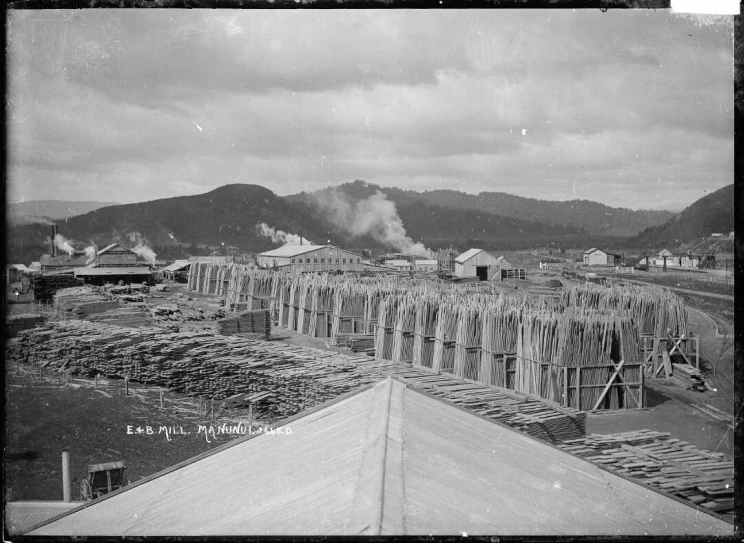
Ellis and Burnand timber mill, Manunui. Price, William Archer, 1866-1948: Collection of post card negatives. Ref: 1/2-000203-G. Alexander Turnbull Library.
What’s next?
This work can’t be rushed. Some collections are significant in size and scope. Others have a complex range of access conditions, such as the papers of former politicians. But we’ll continue to review the restricted manuscript collections and update the Alexander Turnbull Library Catalogue (Tiaki) as we do. We’ll also share another update on the blog in six months’ time.
Read part 2: Adventures in the underworld: A year of reviewing manuscript restrictions
Great work Jared!